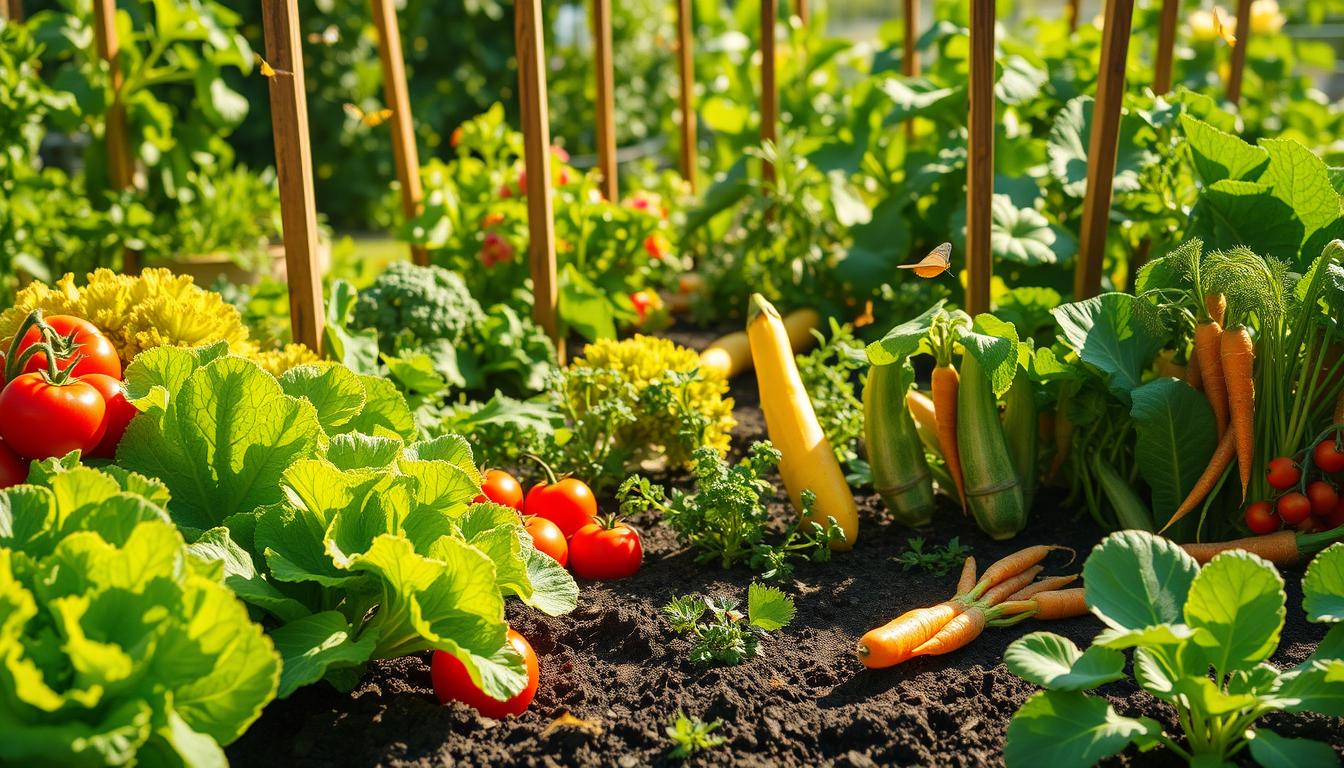Starting a garden can feel like a big task. I’m here to show you the easiest vegetables to grow for beginners. These easy-to-grow vegetables are perfect for new gardeners. With a bit of practice, you can enjoy fresh, homegrown food that’s both healthy and tasty.
Growing your own veggies can be very rewarding. I’ll help you pick the best vegetables for beginners. These veggies do well in different conditions, whether you have a small space or a big garden. You’ll get to enjoy fresh, nutritious food right from your garden.
In this article, I’ll cover all you need to know about growing easy vegetables. I’ll share tips and tricks for beginners. My goal is to help you start your gardening journey and enjoy the fruits of your labor. You’ll learn about the best vegetables for beginners that are easy to care for.
Why Growing Your Own Vegetables Is Important
Growing your own vegetables is a fun and rewarding hobby, perfect for beginners. You get to enjoy the fruits of your labor and have fresh, healthy food right in your backyard. Watching your seeds grow into delicious vegetables is incredibly satisfying.
Some of the benefits of growing your own vegetables include:
- Fresh, nutritious produce without the use of pesticides or chemicals
- A sense of accomplishment and pride in your harvest
- A fun and educational experience for the whole family
Health Benefits of Homegrown Veggies
Homegrown veggies are packed with nutrients, making them a great choice for a healthy diet. By growing your own vegetables, you ensure your family gets the nutrients they need to stay healthy.
Environmental Impact of Vegetable Gardening
Vegetable gardening is also good for the environment. It helps reduce your carbon footprint and supports local food systems. This is especially beneficial for those who want to make a positive impact on their community.
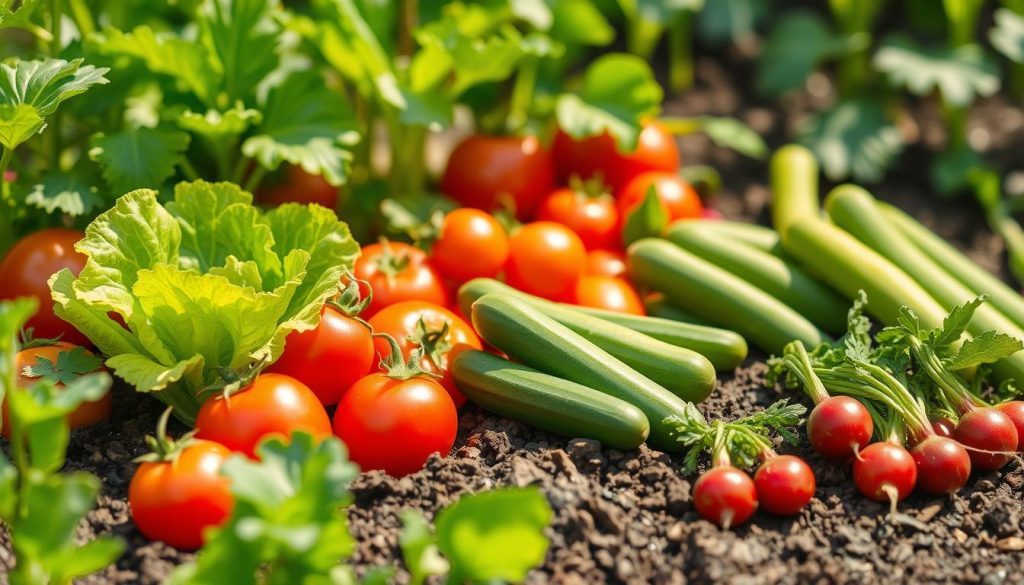
How to Start Your Vegetable Garden
Starting a vegetable garden might seem hard, but it’s easy with the right help. First, pick a good spot for your garden. It should get enough sunlight and water. This will help your garden grow well and be easy to care for.
Think about your area’s climate and soil type. This will help you choose plants that do well there. You’ll need a shovel, rake, and watering can to start. These tools will help you get your garden ready and keep it looking good.
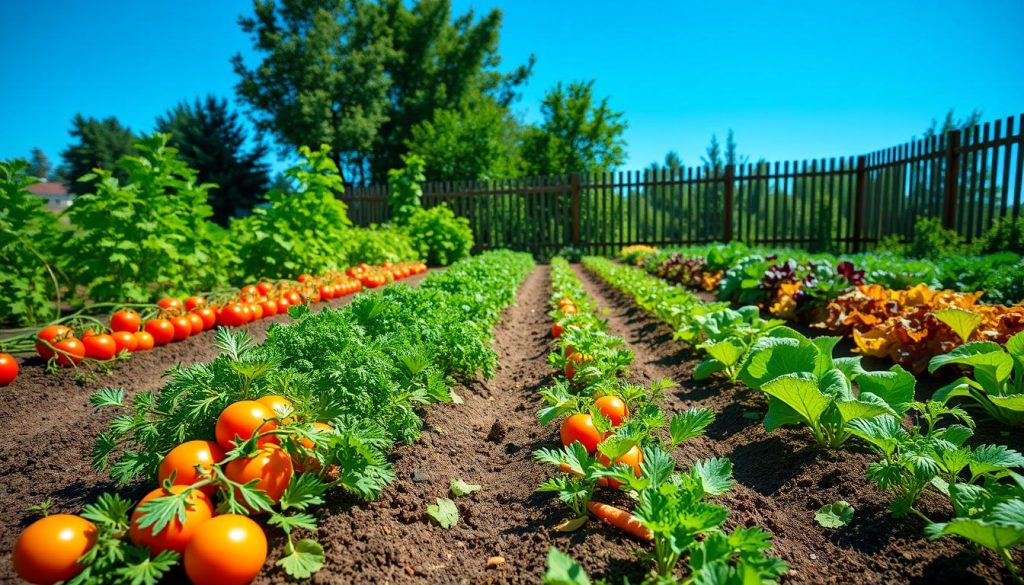
Choosing the Right Location
When picking a spot for your garden, think about the sunlight. Most veggies need at least 6 hours of direct sunlight a day. Also, make sure the area is flat and drains well to avoid soggy soil.
Essential Tools for Beginners
Here are some key tools to get you going:
- Shovel for digging and planting
- Rake for soil prep and weed control
- Watering can for easy watering
These tools will help you create a great garden. It will be full of easy-to-grow veggies and plants perfect for beginners.
Top 5 Easy Vegetables for New Gardeners
Starting with easy vegetables is key for beginners. These plants are simple to care for and grow well in many conditions. I’ll share the top 5 easy vegetables for new gardeners. They’re perfect for those starting their gardening journey.
Some vegetables are easier to grow than others. Here are a few easy veggies for beginners:
- Radishes: They grow fast and are easy to care for.
- Leafy Greens: Spinach and lettuce are quick to harvest.
- Carrots: A fun root vegetable that’s low maintenance.
- Zucchini: It yields a lot and is versatile.
- Green Beans: They’re easy to care for and grow fast.
These vegetables are great for beginners. They help you start your gardening journey with confidence. By choosing these easy vegetables, you’ll enjoy a successful gardening experience.
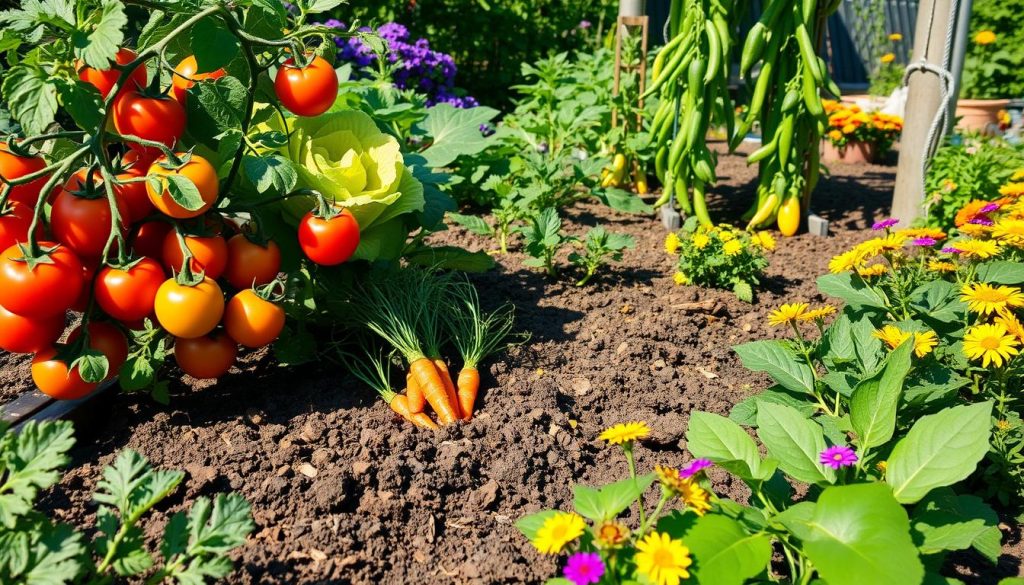
Understanding Your Growing Season
As a beginner gardener, knowing your growing season is key. It changes based on where you live and the weather. Cool-season veggies like lettuce and spinach do well in cooler weather. On the other hand, tomatoes and peppers need warmer weather.
Think about what veggies you want to grow. Zucchini and carrots can grow in both cool and warm seasons. But, they need different care. Knowing what each veggie needs is crucial for a good harvest.
Cool-Season vs. Warm-Season Vegetables
Cool-season veggies like broccoli and kale like cooler temps and can handle light frosts. Warm-season veggies like eggplants and okra need warmer weather and can’t handle frost. Knowing this helps you plan your garden better.
The Importance of Frost Dates
Frost dates are very important for planting. In frosty areas, wait until after the last frost date to plant warm-season veggies. For cool-season veggies, plant when the soil is ready in spring or 8 weeks before fall frost. Knowing your frost dates helps avoid plant damage.
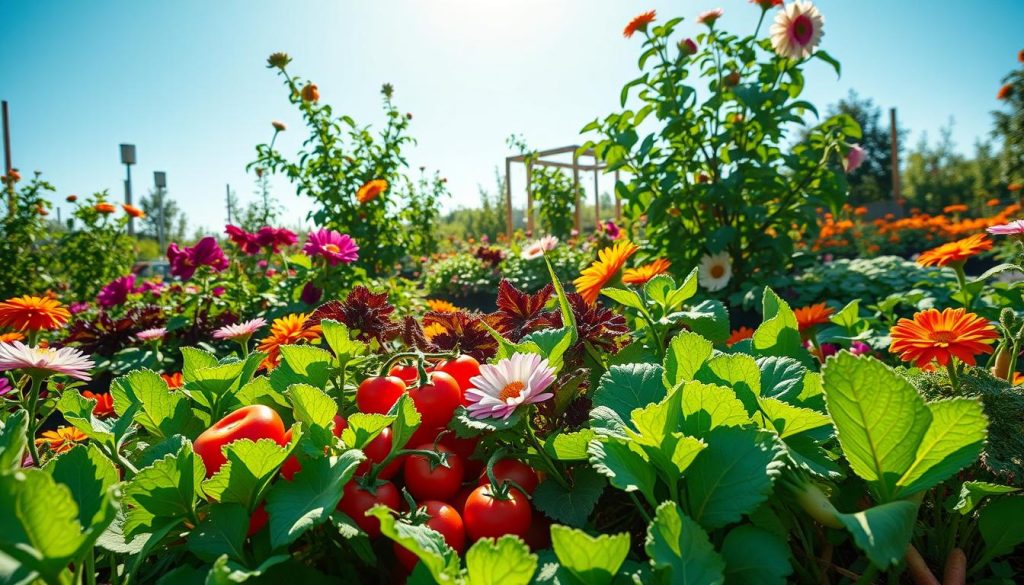
Understanding your growing season and planning well leads to a great harvest. Check your local frost dates and plant at the right time. This ensures your garden thrives.
Best Soil Practices for Beginners
Starting a vegetable garden? I’ve found that good soil is key. It’s the foundation for growing easy vegetables. To make your garden thrive, knowing the best soil practices is crucial.
Amending soil for nutrients is important. Here are some tips to keep in mind:
- Test your soil to determine its pH level and nutrient content
- Add organic matter like compost or manure to improve soil structure and fertility
- Use natural fertilizers like fish emulsion or bone meal to promote healthy plant growth
Amending Soil for Nutrients
Improving soil for nutrients is vital for a healthy garden. By following these tips and using natural amendments, you can create a great environment for your plants.
Tips for Water Retention
To keep soil moist, add mulch or use drip irrigation. These methods save water and ensure your plants get enough moisture. By following these practices, you’ll have a thriving garden.
| Soil Amendment | Benefits |
|---|---|
| Compost | Improves soil structure and fertility |
| Manure | Provides nutrients and improves soil health |
| Fish Emulsion | Promotes healthy plant growth and development |
Container Gardening: A Great Option for Beginners
Starting a garden can feel overwhelming, but container gardening is a great way to begin. It offers flexibility and control over growing conditions. This makes it perfect for beginners. You can grow easy-to-grow vegetables like tomatoes, peppers, and cucumbers.
When picking containers, think about size and material. Big containers are good for plants that need more space. Small containers are better for herbs and leafy greens. Beginners should choose easy-to-care-for veggies that need little maintenance.
Benefits of Container Gardening
- Flexibility: Container gardens can be moved to different locations to optimize sunlight and temperature.
- Control: Container gardens allow for better control over soil quality, watering, and fertilization.
- Space-saving: Container gardens are perfect for small spaces, such as balconies, patios, or rooftops.
Radishes, carrots, and zucchini are great for container gardening. They are easy to grow and do well in containers. By following these tips and choosing the right containers and vegetables, you can create a thriving garden. This garden will give you fresh, delicious produce all season long.
Getting Started with Container Gardening
To start container gardening, pick your containers and vegetables, and plant them. With a little care and attention, you’ll enjoy fresh, homegrown produce soon. Choose easy-to-grow vegetables for beginners. If you have questions or need help, don’t hesitate to ask.
| Vegetable | Container Size | Growing Conditions |
|---|---|---|
| Tomatoes | Large | Full sun, well-draining soil |
| Peppers | Medium | Partial shade, moist soil |
| Cucumbers | Large | Full sun, well-draining soil |
Pest Control Tips for New Gardeners
Starting to grow vegetables can be very rewarding. But, you need to watch out for pests that can harm your plants. Using organic pest control methods is a good way to keep your garden healthy.
Pests like aphids, whiteflies, and spider mites can be a problem. Look for signs like holes in leaves or a sticky substance. Here are some tips to manage these pests:
- Use neem oil to control aphids and whiteflies
- Introduce beneficial insects, such as ladybugs, to prey on pests
- Keep your garden clean, and remove any weeds that can harbor pests
By following these tips, you can keep your garden balanced and enjoy a good harvest. Remember, pest control is an ongoing task. Always check your garden regularly to stop infestations.
As a new gardener, learning about integrated pest management is key. It means using different methods to manage pests. This way, you can use fewer chemicals and make your garden a healthier place for your plants to grow.
| Pest | Signs of Infestation | Organic Control Method |
|---|---|---|
| Aphids | Holes in leaves, yellowing of leaves | Neem oil, soap solution |
| Whiteflies | Yellowing of leaves, sticky substance on plants | Neem oil, yellow sticky traps |
| Spider mites | Fine webbing on plants, yellowing of leaves | Neem oil, insecticidal soap |
When to Harvest Your Vegetables
Harvesting your vegetables at the right time is key for the best taste and texture. As a beginner, knowing when to pick your vegetables is crucial. Growing easy-to-grow plants can be rewarding, but you must pay close attention to harvesting.
Signs of Ripeness
Each vegetable has its own sign of ripeness. Tomatoes are ready when they’re fully red. Cucumbers are best when they’re dark green and 6-8 inches long. Knowing these signs is important for a successful harvest.
Proper Harvesting Techniques
To harvest your vegetables right, use scissors or a sharp knife. This avoids damaging the plants. For root vegetables like carrots, gently dig around with a fork. These simple tips help you enjoy a rich harvest of delicious vegetables.
| Vegetable | Signs of Ripeness | Harvesting Technique |
|---|---|---|
| Tomatoes | Fully red | Twist and pull gently |
| Cucumbers | Dark green, 6-8 inches long | Cut with scissors or a sharp knife |
| Carrots | Orange, 1/2 to 1 inch in diameter | Gently dig around with a fork |
Cooking with Your Homegrown Vegetables
Growing your own veggies is very rewarding. You get to enjoy them in many dishes. Start with easy veggies like tomatoes and cucumbers. They’re great for salads, sandwiches, and simple recipes.
There are endless ways to cook with your homegrown veggies. Use them in soups, stews, stir-fries, and baked goods. Carrots, zucchini, and bell peppers are great for beginners. They’re versatile and work well in many dishes.
Simple Recipes for Fresh Produce
- Grilled vegetable skewers with easy-to-grow vegetables like cherry tomatoes and mushrooms
- Roasted vegetable soup with beginner-friendly veggies like carrots and celery
- Stir-fry with best vegetables for beginners like broccoli and bell peppers
Preserving Your Harvest for Later
Preserving your harvest is a smart move. It lets you enjoy your veggies all year. Freeze, can, or dehydrate them for later use. Tomatoes, cucumbers, and green beans are great for beginners.
Common Mistakes to Avoid as a Beginner
Starting a garden can feel overwhelming, especially for beginners. But, with the right tips and patience, you can grow a great garden. Avoiding mistakes like overwatering and planting too close is crucial.
Overwatering: A Gardener’s Pitfall
Many new gardeners water their plants too much. Vegetables need moisture, but too much can harm them. Check the soil before watering and only add water when it’s dry.
By paying attention to your plants, you can find the right watering balance.
Planting Too Close Together
Planting too many plants together is another mistake. It might seem like a good way to use space, but it can harm plants. Make sure to follow the spacing guidelines for each plant.
By avoiding these mistakes and following the tips in this guide, you’ll have a successful garden. Start small and choose easy-to-grow vegetables. Happy planting!

